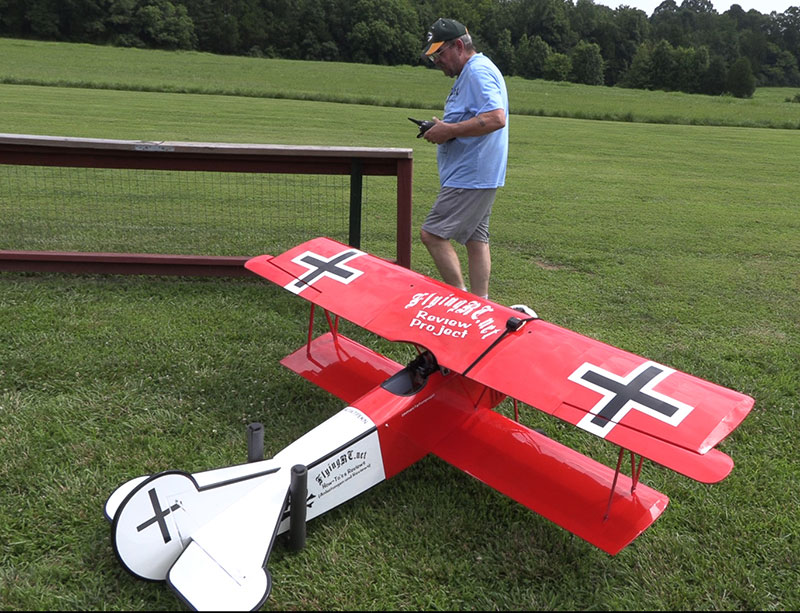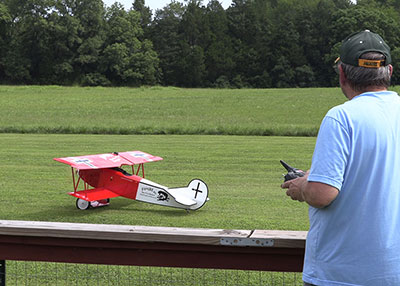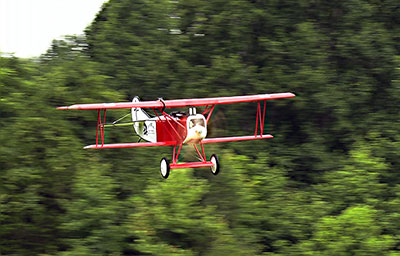



There is always a bit of nerves when bringing out a new plane to see if it flies. I shouldn't have worried about
my new D7, it flew great.
Text and photos by Tom Hintz
Flight video by Dennis Shaver
Posted – 7-4-2019
Note: FlyingRC.net Protector sets and components now available for the Hangar 9 D7! - Click Here
Maiden days can be stressful. When the new plane breaks free of the runway we are faced with the moment of truth when a bunch of money takes to the air and we get to see if it all works as expected. Maiden day for the Hangar 9 Fokker D7 was hot with mostly reasonable winds, some cross-runway gusting and partly cloudy skies. That left me with no legitimate excuse to not fly it.
On the way to taking off for the first time I got to see how the Hangar 9 Fokker D7 taxied in the grass with no steerable tail wheel. The original Fokker D VII had a wooden skid and the Hangar 9 Fokker D7 has a plastic representation of that. The model has a spring on the skid to help absorb some of the bumps, but it does not steer.
I was pleasantly surprised with how the Hangar 9 Fokker D7 “drives” overall. It does turn albeit in a somewhat wider arc. On takeoffs the Hangar 9 Fokker D7 tail comes up quickly and the rudder provides good directional control. No hammering of the rudder stick is needed.
We had some gusty crosswinds on maiden day and the Hangar 9 Fokker D7 teaches you to anticipate turns a little. In the maiden video there is one instance where the Hangar 9 Fokker D7 turns right rather tightly but you can see the rudder is nearly full left. The Hangar 9 Fokker D7 has considerable side surfaces so tending to “weather-vane” is something to be anticipated.
My best guess for the maiden was a Vess 23B prop on the DA50R. I have flown that prop on a bunch of 50cc planes and most of them were happy with it. It turns out the Hangar 9 Fokker D7 is also happy with the Vess 23B. It pulls well, the engine does not seem to over-rev on down lines and all-around throttle response (after one mixture tweak) was fine.
I gave the Hangar 9 Fokker D7 a good amount of elevator as it neared the end/edge of the runway and it lifted off smoothly. I realized right away that this is no plane to be jerking out of the grass. It felt just a bit mushy because I forced a little too steep a climb. Keep the climb out relatively shallow for a few seconds and the Hangar 9 Fokker D7 quickly builds speed and flies out easily.
The biggest surprise during the maiden flight was how little trim it needed. I literally added two clicks of down trim and my new Hangar 9 Fokker D7 flew hands-off. That lack of needed trim carried over to landing approaches as well. There is little change in how the Hangar 9 Fokker D7 flies between slow and fast, something I find refreshing in a biplane/warbird.

Ground handling is a little slow with a stick in place
of a steerable tail wheel.
I cut the first flight short as the engine was running a little richer than I like, and I did not want to try the Hangar 9 Fokker D7 in a dead stick. I also got to find out that while the Hangar 9 Fokker D7 has a healthy sink rate, the controls remain responsive and it is a puppy to land.
With the DA50R leaned out less than 1/8-turn the Hangar 9 Fokker D7 took off with more authority but still needs a shallow initial climb. With the engine now “happy” the Hangar 9 Fokker D7 continued to fly well. It did not seem to be much faster than during the maiden flight but the Hangar 9 Fokker D7 is reasonably quick. The flat-bottomed wings are not as thick as I anticipated and apparently get through the air well.
The DA50R is one of the strongest 50cc engines made so when combined with momentum, the Hangar 9 Fokker D7 has a bit of vertical, enough to do nice stall/rudder turns. The rudder is surprisingly effective at the lower speeds at which I was doing those stall turns. We also noted that the engine was not sagging on a steep up-line, further evidence the DA50R was happy at that mixture setting.
I tried the Hangar 9 Fokker D7 inverted and it is stable with moderate amounts of down elevator needed to maintain level flight. The first time I rolled the Hangar 9 Fokker D7 back to right-side-up it appeared to fall off the edge of a table while in the knife edge position. It didn’t go into a free fall, but it does get your attention. I continued to hold the ailerons to get it back level and it flew out of it.
I don’t consider this to be a problem with the plane but rather me expecting a 27lb biplane to right itself like an Edge. A little bit of rudder and some elevator smooths that roll back to right side up and makes it look coordinated, as it should be if I was flying it through the maneuver.
The Hangar 9 Fokker D7 likes the rudder – a lot. You can literally make many turns using the rudder with a bit of counter aileron to control the angle of the wings. At this writing I have not tried throwing the Hangar 9 Fokker D7 around much but suspect there will be no rudder-related surprises there.
The rudder, at moderate throw, remains effective at lower speeds and there was no obvious tendency for the wings to rock or dip, something that could signal an imminent snap roll. While I am confident in the rudder on the Hangar 9 Fokker D7, further testing at increased throw inputs, particularly at reduced speeds, will be done a few mistakes high so I can more safely find its limits and what it takes to recover if that is needed.

With the DA50 this is not a 3D plane but it gets
around the sky just fine for a plane this big. Plus, it
is very predictable in the air.
The Hangar 9 Fokker D7 has only top wing ailerons so the decidedly non-blurring roll rate should be no surprise. However, it is realistic, and you get to practice adding a bit of elevator to help keep it level while doing lazy aileron rolls. That said, aileron authority remains at surprisingly low speeds.
As with virtually any plane, more power expands its capabilities. The Hangar 9 Fokker D7 was designed to accept 60cc power and that gives this WWI warbird a bunch of vertical and other aerobatic capabilities. That lets the purchaser decide how to equip the Hangar 9 Fokker D7 to best fit their style of flying.
During maiden day at the field I was texting with a friend in Florida who is interested in getting a Hangar 9 Fokker D7. After I (and friend Dennis) had flown the Hangar 9 Fokker D7 that friend asked “So, it’s a keeper?”. The simple answer was, absolutely.
In my estimation the Hangar 9 Fokker D7 is solidly rooted in a surprisingly small segment of the warbird world primarily because it is so easy to fly and so predictable. This is a fun plane to fly. I have yet to find a bad habit in this airframe and suspect some form of pilot error will be needed to produce one. Fly the Hangar 9 Fokker D7 within its expansive flight envelope and all is right in your RC world.
Biplanes are notoriously sensitive to gusty winds. At our field those gusts are worsened at either approach to the runway where wind rolls over the tops of trees. I have had giant scale planes do very odd things as they came through that area of turbulence including a giant biplane that flipped completely over, belly up less than 20 feet off the ground.
The Hangar 9 Fokker D7 does get bounced around a bit in gusty winds, mainly because it has two wings. However, it was far more manageable than I expected in those conditions. Like all the great flying planes I have had, the Hangar 9 Fokker D7 smooths out when it gets within a few feet of the runway surface, making it refreshingly easy to land.
Before flying the Hangar 9 Fokker D7, if someone had told me a 27+-pound biplane could be considered a floater I would have thought they had bubbles in their think tank. The Hangar 9 Fokker D7 isn’t a floater on the scale of Hangar 9’s 30cc Valiant, but it is close. This airframe uses the air well.
For a biplane, the Hangar 9 Fokker D7 is quick and easy to assemble as well as break down at the field. Combine that with its pilot-friendly handling and the Hangar 9 Fokker D7 becomes a legitimate everyday flier, a quality that is exceptionally rare in a legitimate warbird.
I would not say the Hangar 9 Fokker D7 is a beginner plane but given intermediate flying skills and some help from an experienced pilot, the Hangar 9 Fokker D7 can be your first giant scale and/or first warbird.
The 8”-tall wheels are scale, but they also make the Hangar 9 Fokker D7 compatible with nearly any prepared runway. It is hard to imagine grass being tall enough to slow the Hangar 9 Fokker D7. Its slow speed handling allows flying on shorter runways than you might think.
If you are looking for a big biplane and/or warbird, the Hangar 9 Fokker D7 is a must-see.
Have a comment on this Review? –Email Me!